|
The Saab MFI-15 Safari, also known as the Saab MFI-17 Supporter, looks like it would
be an excellent subject for a scale aircraft that would be easy to fly, and there are many physical
and color configurations to choose from. Saab-Scania is the company that developed both the Drakken
the Viggen supersonic fighter airplanes, so they knew what they were doing when designing the MFI-17
as a dual role platform that was used both as a primary trainer and as a close support anti-tank aircraft.
Its 200 HP, fuel-injected engine provided plenty of power and payload capability and combined with a
robust airframe, made it fully aerobatic. A very unique feature is the swept-forward wings, which is
credited for the craft's STOL performance.
Swedish Hocus Pocus
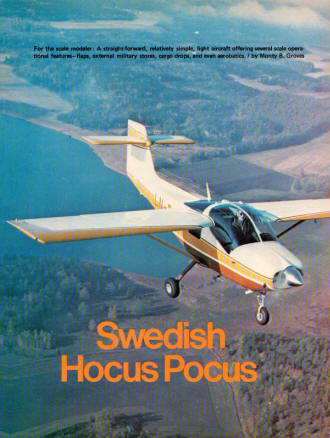
For the scale modeler: A straight-forward, relatively simple, light aircraft offering
several scale operational features - flaps, external military stores, cargo drops, and even aerobatics.
by Monty B. Groves
A unique demonstration of Swedish aviation magic has been unfolding over the past couple of years
in the form of a totally versatile, rugged utility aircraft that is being assembled in small numbers
at the Saab-Scania factory in Malmo, Sweden.
While Saab-Scania is a leader in the design and production of such advanced Mach 2 military aircraft
as the Model 35 Drakken and the utterly fantastic Viggen (See AAM,
January, 1974), they also are starting to field test, display and market a light military airplane
that has been designated the MFI 17 "Safari."
The Saab MFI 17 is an excellent, multipurpose, light utility aircraft which is certain to be utilized
by many developing nations for its light military and nonmilitary applications. It has the capability
of converting, almost instantly, into a cost-effective, adaptable weapons system for low intensity engagements.
The shoulder wing, single engine plane is a true quick-change artist and, because flexibility is
the basic design philosophy, it can assume many guises. In addition to being a close-in, ground support
weapons platform, it can also be used for police work, basic gunnery and aerobatic flight training,
agricultural spraying, target towing, aerial photography, general liaison missions, and for dropping
supplies.
Its maneuverability, slow flight and STOL characteristics make it easy to operate from unimproved
roads or strips that are in close proximity to the action. A 200 hp, fuel-injected Lycoming (relatively
safe from IR-seeking missiles from the ground) permits successful, quiet, "slip up on 'em" missions.
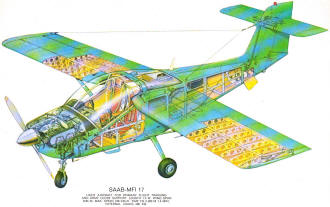
Light Aircraft for Primary Flight Training and Army Close Support. Length 7.0 M.
Wing Span 8.85 M. Max. Speed 248 KM/H. Time to 2,000 M 7.4 Min. External Loads 300 Kg.
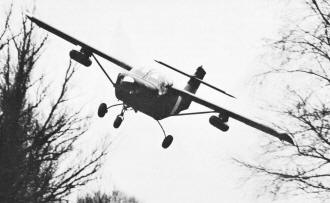
Coming in fast among the trees in a low-level strike mission, and armed with rocket
pods, the Safari clearly demonstrates it is flexible, but not limp. (All photos courtesy Saab-Scania)
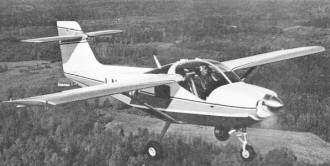
The civilian version of the Safari, the MFI 15, has the same configuration, but without
the pylon mounts for external stores.
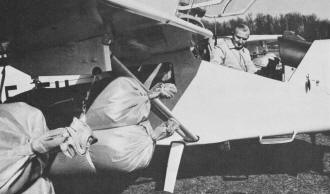
Count Gustav von Rosen preflights the Safari prior to his relief air drop mission
in Ethiopia. Over 660 lb. of sorghum seeds are visible on the Saab-MFI 17's wing mounts.
The concept of this aircraft began as a homebuilt in San Diego, Calif.1 First flown in
1958 as the BA-7, it was designed, built and flown by a Convair employee, Bjorn (Andy) Andreasson. Registered
as N2806D, it was powered by a 75 hp Continental A75, and had a wingspan of 23 ft. In 1962, Andreasson
returned to h is homeland of Sweden, and by 1964, a refinement of his original design was designated
the MFI 9, and was being assembled in limited numbers at Malmo. Power for the production MFI 9 was increased
to a 100 hp Continental engine.
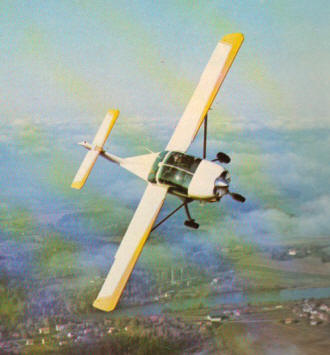
As a follow-up program, the MFI 15 was conceived and built. Larger in all dimensions, the wingspan
and length were increased to 29 and 23 ft., respectively, and the power plant was increased to a 160
hp Lycoming. Basically a primary trainer, the MFI 15 has undergone evaluation by various nations as
a possible replacement liaison aircraft. Saab began a vigorous sales effort end after delivery of between
10 and 20 MFI 15 "trainers" to the small African country of Sierra Leone, the wing structure was beefed
up to allow external load mounting. The resulting military mode was designated MFI 17.
The Safari was developed in accordance with U.S. Federal Air Regulation Part 23 covering Normal,
Utility and Aerobatic categories, and can also be operated in the Restricted category for military use.
The all-metal, stressed-skin MFI 17 is equipped with three seats, and is fully aerobatic (maximum load
limit of +6/-3 Gs.
Inside and out, the Safari is pure utility. A no-nonsense, well-designed, fully equipped instrument
panel with American radio gear) is presented to the pilot, who is enclosed in a well-glazed canopy designed
to provide excellent all-around visibility. All instrument gauges are in English units. Normally equipped
with tricycle gear, the MFI 17 can be configured as a tail dragger with a combination wheel/ski undercarriage.
Constructed in two identical legs that are attached to the main wing support frame, the main landing
gear, although conventional in appearance, is a lightweight and rugged, glass fibre reinforced, plastic
material. The cowling, wing tips, elevator and vertical fin are also constructed of the same material.
For ease of maintenance, the cowling is quickly removed, and engine accessibility is provided b a
special drop-down bracket that tilts the Lycoming.
The wings are unique in appearance in that they are swept forward 5°. They contain the total
gasoline capacity of 50 U.S. gallons tanks, allowing 5 1/2 hours endurance. Its internal and external
load carrying capacity, coupled with excellent visibility and flight characteristics, provide versatile
options to the civilian or military operator.
SAAB-MFI 17
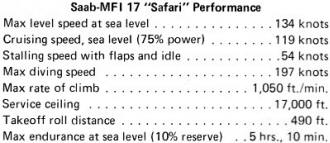 Under the wings are innocent-looking pylon mounts that can turn
this training or liaison aircraft into a deadly close-in attack weapon. With 660 lb. external carrying
capacity under the wings, the military stores can be quickly varied according to the mission - Bofors
antitank missiles, air-to-surface rockets, GE Miniguns or various combinations of each make up an effective
and flexible kill capacity. Under the wings are innocent-looking pylon mounts that can turn
this training or liaison aircraft into a deadly close-in attack weapon. With 660 lb. external carrying
capacity under the wings, the military stores can be quickly varied according to the mission - Bofors
antitank missiles, air-to-surface rockets, GE Miniguns or various combinations of each make up an effective
and flexible kill capacity.
But the first real test of the Safari's ruggedness is currently being demonstrated in Ethiopia. Instead
of rockets or guns, the pylons are slung with disposable bags filled with a special kind of seed corn.
In cooperation with the Swedish Section of the Lutheran World Federation, the Swedish Red Cross, the
Save the Children Fund and Saab, three MFI 17s (SE-FII, SE-GHK and SE-FIK) are being used in an attempt
to save thousands of natives from starving in the Ethiopian back country.
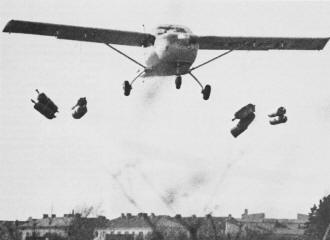
Low and slow, with flaps down, one of Count von Rosen's Ethiopian relief aircraft
demonstrates the food-dropping technique at Malmo prior to deployment.
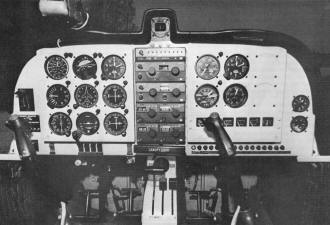
The MFI 17's functional cockpit is complete with dual controls, reflecting gunsight,
and a utilitarian arrangement of flight instruments and engine gauges, all marked in English units.
Organized and under the command of Count Carl Gustav von Rosen of Sweden, a special team is involved
in dropping over 13,000 lb. of sorghum seed each day. Flying six to seven hours daily since April, 1974,
the three airplanes have been making relief food air drops "on target" at the extremely low altitudes
of 3 to 15 ft.
This unique application of an aircraft is certainly nothing new to the 65-year-old count, whose adult
life portrays a true airborne soldier of fortune. He fits this image with his flying adventures, as
well as his appearance. Lean and just under six feet tall, the count has steel gray hair and eyes to
match.
A childhood filled with aviation lore and African adventure formed the basis for all the "derring-do''
of Gustav von Rosen's manhood. His father, Count Eric von Rosen, was an African safari adventurer and
aviation enthusiast. And, because he donated their first aircraft, the elder von Rosen is considered
the father of the Finnish Air Force.
On March 6, 1918, a Thulin-built Morane Parasol, flown by Lt. Nils Kindberg (Swedish pilot certificate
No. 25), was delivered to Vassa, Finland, after a flight from Umea, Sweden. Emblazoned on the airplane
was the von Rosen "good luck" symbol, a large blue swastika on a white field. This insignia was adopted
and remained the official marking of the Finnish Air Force for the next 28 years.
Some of the leading aviation figures of the Twenties were frequent visitors at the von Rosen estate
far outside of Stockholm. And, among one of the most frequent was one of World War l's surviving Pour
le Merite holders, Hermann Goering. Not only did he become Gustav's uncle by marriage, but Uncle Hermann
later became commander-in-chief of Germany's swastika-marked Luftwaffe.2
In these surroundings, Gustav became totally enveloped in the romantic age of speed and adventure.
Yearning to be a racing driver, the teenage Gustav ran away from home and raced cars for awhile. This
resulted in his father's refusal to speak to him for over five years. After obtaining a flying license
at the age of 19, young von Rosen flew for an aerial circus for several years before he became involved
in his first African adventure. During 1935-36, he organized a Red Cross Flying Relief Mission for the
Ethiopians during the Italian invasion. Slightly exceeding his role as a "relief pilot," the neutral
Swede soon had a $10,000 price placed on his head by the Italians.
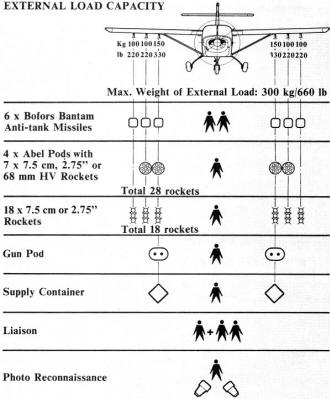
Then, after a two-year stint as a flight captain for KLM,
Gustav followed in the footsteps of his father by rushing to the aid of the Finns when the Soviets
The precursor to the Safari, the MFI 9, with full flaps down, convincingly demonstrates its STOL
performance in a crosswind from an unimproved strip.
invaded that country in 1939. As a flying volunteer, he personally flew scores of combat missions
in his bomber conversion of a Douglas DC-2, in addition to acquiring other aircraft for the Finns in
their valiant (but futile) attempt to stem the Russian advances.3 Returning to his neutral
homeland, he flew with the Swedish airline, ABA, from 1940 through 1946.
With all of Europe engaged in total war, this neutral Swedish airline pilot managed to optimize his
involvement without actually participating. He flew the weekly courier flights from Stockholm to Berlin.
Undoubtedly, there occurred events of deep international intrigue during that period, and an accurate
list of passengers and cargo surely would be illuminating.
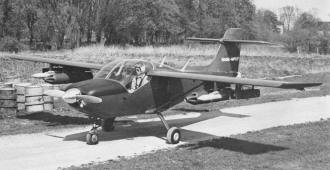
Even with fixed gear and mixed rocket payload slung under the wing, the MFI 17 presents
a "clean" appearance.
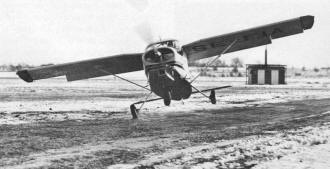
The precursor to the Safari, the MFI 9, with full flaps down, convincingly demonstrates
its STOL performance in a crosswind from an unimproved strip.
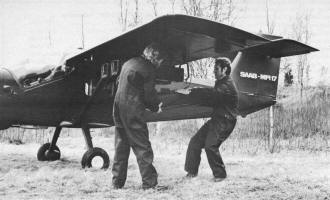
With minimum ground crew support, pods with Bofors Bantam antitank missiles are easily
attached in a "forward" area.
After the Big War, he was appointed the first chief of the Ethiopian Air Force, which he soon augmented
with Saab-B 17 light bombers and Saab-Safir light aircraft.
Count von Rosen attained international prominence in 1968, when he organized an "air bridge" of relief
supplies to the Nigerian-blockaded Biafrans.3 Flying night supply missions over secret routes
from the Portuguese island of Sao Tome, his airlift was successful in breaking the Nigerian blockade,
even though the DC-7Cs and Constellations were continuously being harassed by Russian-built MIG 17s
of the Nigerian Air Force.
In May, 1969, the shining shield of Swedish neutrality suddenly became somewhat tarnished when the
news media reported that nine small camouflaged light aircraft, without national insignia, that had
attacked Nigeria, were being flown by "Swedish mercenaries." (Guess who?)
The light aircraft were armed MFI 9 training craft which somehow had found their way into Africa
from Sweden and France, and were assembled into an unusual strike force under the command of the count.
These single-engine, light aircraft successfully attacked oil fields and power stations with pylon mounted
rockets, and destroyed 11 MIG-17 fighters and Ilyushin bombers, catching them on the ground at a Nigerian
Air Force Base.
Needless to say, there was considerable consternation on the part of the Swedish Government. Not
only were Swedish nationals involved in a "private war," they were being led by a titled Swede who was
flying a Swedish-built airplane. Count von Rosen caught hell from the prime minister of Sweden. (On
the other hand, Saab-Scania, the manufacturer of the MFI 9, was most certainly aware of the international
sales potential of such a successful concept which had been clearly and convincingly demonstrated.)
The original Andreasson design continued through the refining process. Its wings were strengthened
to accept more payload; it was re-engined to accept the 200 horses of the Lycoming IO-360, and eventually,
the small MFI 17, whose mother had been a "MIG-killer," was born in Malmo.
The name "Safari," given to the MFI 17 is appropos of von Rosen's interest, involvement and adventures
in Africa and in aviation. The Safari promises to be a successful contender in the growing world market
for a rugged, multi-purpose, light airplane of a militant or nonviolent nature.
As yet unseen within the U.S., it is reported that Saab-Scania will demonstrate the Safari's attributes
and capabilities in the Western Hemisphere in early 1975. Saab hopes to establish a marketing agreement
with some established North American firm.
In the January AAM, Patricia Groves explores the evolution of Anthony Fokker's "secret" airplane
and the Luftwaffe's hidden air force, in "Germany's Quiet Birdmen."
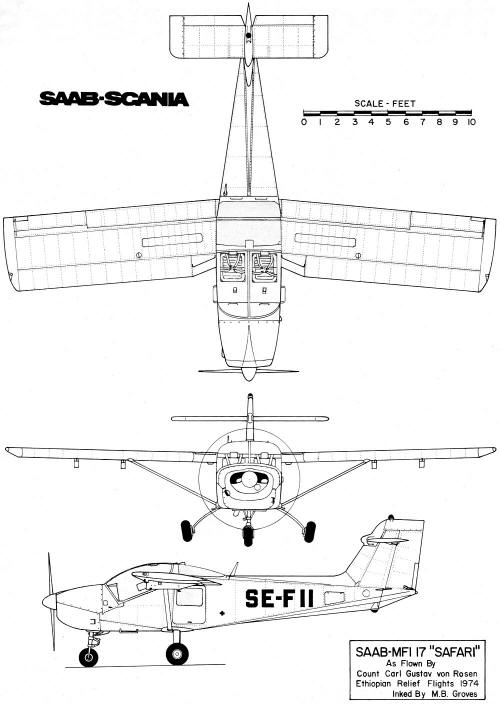
Saab MFI-15 / MFI-17 3-View Drawing - As Flown by Count Carl Gustav von Rosen, Ethiopian
Relief Flights, 1974
References
1. Journal of the American Aviation Historical Society (Vol. 17, No.2) 1972, "von Rosen and the Mini
Warplanes," Mauno Sale.
2. William L. Shirer, The Rise and Fall of the Third Reich New York: Simon and Schuster, 1960 .
3. Encyclopedia Britannica Year Book, 1969.
SAAB-MFI 17 "Safari"
Inked By M.B. Groves
Posted March 26, 2016
|